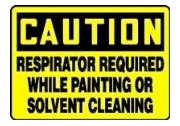 |
|
Please note: This summary is provided to help you understand the regulations. Consult the references provided for links to the full text of the regulations.
This section provides information about environmental regulations governing cleaning with petroleum-based solvents. Other types of cleaning operations are covered elsewhere on TERC, including:
Who is covered by the regulations? Any facility carrying out processes that involve cleaning with petroleum-based (non-water-based) solvents. Examples include degreasers and solvent parts washers used to clean water-insoluble contaminants such as grease, oils, and carbon deposits from vehicle parts at maintenance operations. The regulations also cover the use and disposal of solvent wetted rags to manually wipe soils from the metal surfaces (hand wiping). What is the purpose of the regulations? With all solvent cleaning processes there are two major environmental concerns:
The first part of this section covers regulations that apply to emissions of solvent vapors to the atmosphere. The second part covers regulations that apply to disposal of solid and liquid wastes that contain solvents. Regulations for Air Emissions Solvent vapor emissions regulations that affect the transportation sector are primarily contained in two standards, generally referred to as NESHAPs (National Emissions Standards for Hazardous Air Pollutants).
See the TERC pages on the Halogenated Solvent NESHAP and the Aerospace NESHAP for details on their requirements. Many vehicle maintenance facilities operate self-contained solvent cleaning units that are serviced by a commercial provider. Often, such units contain solvents that are not covered under the Halogenated Solvent Cleaning NESHAP. However, special rules may apply to these types of units in some states. In addition to the federal rules, states and regional air districts have established a variety of regulations that impact solvent cleaning. In general, these rules can be met by using add-on controls, modifying equipment, improving work practices, or upgrading to using a lower emitting solvent. See the State VOC Regulations page for more details. Regulations for Solid and Hazardous waste Solvent cleaning generates solid wastes, some of which may be considered "hazardous waste," a specific regulatory category that imposes special obligations for managing and disposing of the waste. It is the generator's responsibility to determine whether any particular waste falls under the "hazardous waste" category (see Hazardous Waste Determination). The most common wastes generated by solvent cleaning are:
Spent solvents are almost always a hazardous waste, as defined by the Resource Conservation and Recovery Act (RCRA). Most commonly used solvents have flashpoints below 140°F, making them highly ignitable. A spent solvent can also be a hazardous waste listed on the EPA hazardous waste list, which means that it contains organic solvents that have been identified as being hazardous (tetrachloroethylene, trichloroethylene, xylene, toluene, methyl ethyl ketone, and benzene). Spent solvents are also usually hazardous because they pick up toxic metals such as lead from parts and equipment cleaned in the parts washer. Solvent parts washers generate sludge, which is usually hazardous because it contains toxic metals and solvents from the parts cleaned. Solvent contaminated wipes (i.e., shop towels, rags, etc.) are also regulated under RCRA. However, the applicable rules for wipes changed in 2013, at least on the federal level. The "Solvent-Contaminated Wipes" rule conditionally excludes wipes that are contaminated with solvents from certain hazardous waste requirements. Specifically, the rule modifies RCRA regulations for solvent-contaminated wipes that are:
To be excluded, solvent-contaminated wipes must be managed in closed, labeled containers and cannot contain free liquids when sent for cleaning or disposal. Additionally, facilities that generate these wipes must comply with certain recordkeeping requirements and may not accumulate wipes for longer than 180 days. Facilities that generate wipes should carefully read the Solvent-Contaminated Wipes rule (Federal Register, July 31, 2013) and refer to EPA summary and guidance information. Also, it is very important to note that authorized RCRA states are not required to adopt these conditional exclusions. Use the RCRA Hazardous Waste State Resource Locator to find the specific rules for your state and a point of contact at your state environmental agency. Hazardous waste must be managed, stored, transported and disposed of in accordance with specific federal and state regulations. The exact rules applicable to a given facility depend on the quantity of hazardous waste generated each month. For example, "small quantity generators" have fewer requirements than large quantity generators. For more information see Hazardous Waste. Rules also vary somewhat from state to state. Use the RCRA Hazardous Waste State Resource Locator to find the specific rules for your state and a point of contact at your state environmental agency. Best Management Practices (BMPs) Most regulations tell you what you have to do to be in compliance, but they don't explain how to do it. That's where "best management practices" come into play. BMPs are proven methods that help you to get into compliance and stay there. The following BMPs are recommended for solvent cleaning.
National Small Business Environmental Assistance Program. Section 507 of the 1990 Clean Air Act Amendments requires each state establish a Small Business Environmental Assistance Program (SBEAP) to assist small businesses with environmental compliance and emissions reduction. Find your SBEAP state contact. Rule and Implementation Information for Halogenated Cleaning Solvents (EPA) - EPA lists numerous documents associated with the rulemaking. How the Clean Air Act Affects Halogenated Solvent Cleaning Operations - Fact sheet published by the Michigan Department Of Environmental Quality.
|
 Cleaning, Solvent
Cleaning, Solvent Two sets of regulations have been developed to address these concerns.
Two sets of regulations have been developed to address these concerns.